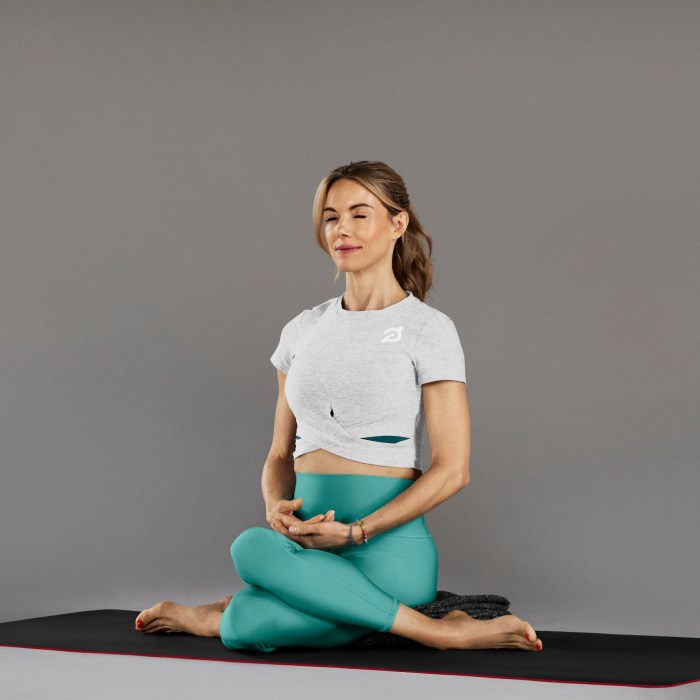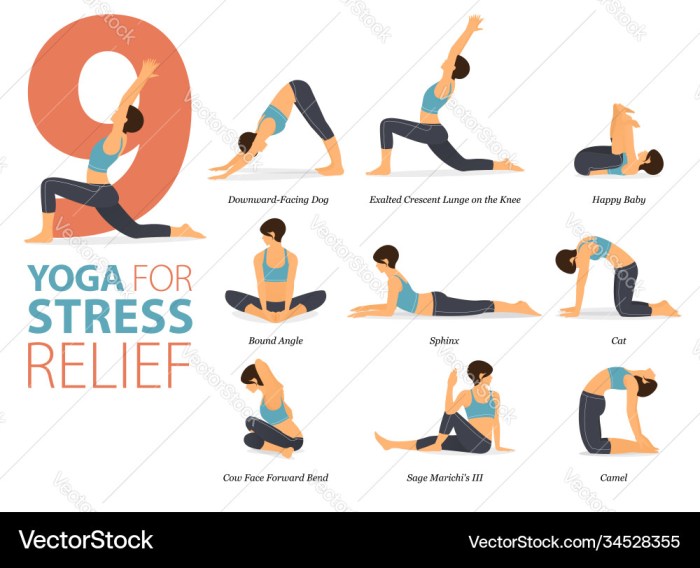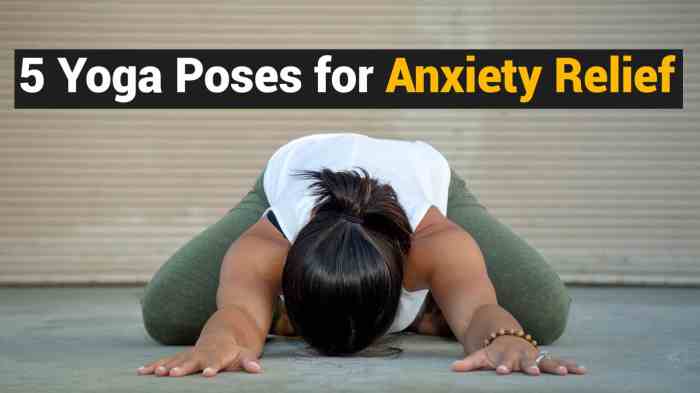Yoga for Stress Relief: Find Your Inner Peace

Yoga for stress relief is more than just a trendy exercise; it’s an ancient practice rooted in mindful movement and breathwork that can transform your relationship with stress. From its origins in ancient India to its modern-day popularity, yoga has been recognized for its ability to calm the mind, soothe the body, and cultivate a sense of inner peace.
The benefits of yoga for stress relief are backed by scientific evidence. Yoga poses, or asanas, promote flexibility and strength, while breathing exercises, or pranayama, help regulate the nervous system and reduce anxiety. These practices work together to create a sense of balance and well-being, allowing you to navigate life’s challenges with greater ease.
Introduction to Yoga for Stress Relief
Yoga, an ancient practice originating in India, has long been recognized for its profound impact on physical, mental, and spiritual well-being. Its roots are traced back thousands of years, with its principles and techniques evolving to address various aspects of human existence, including stress management.
Yoga’s effectiveness in reducing stress stems from its holistic approach, encompassing physical postures (asanas), controlled breathing (pranayama), and mindfulness practices. These elements work synergistically to alleviate stress by promoting relaxation, reducing muscle tension, and calming the mind.
Physiological Benefits of Yoga for Stress Reduction
Yoga’s impact on stress reduction is rooted in its physiological benefits. Regular practice can significantly improve physical health, leading to a reduction in stress levels.
- Reduced Muscle Tension: Yoga postures, such as forward bends and twists, release tension in muscles, particularly those in the neck, shoulders, and back, which are often affected by stress.
- Improved Cardiovascular Health: Yoga’s gentle movements and breathing exercises can lower blood pressure and heart rate, promoting cardiovascular health and reducing stress-related cardiovascular risks.
- Enhanced Respiratory Function: Pranayama techniques, such as deep breathing exercises, improve lung capacity and oxygen intake, reduce feelings of anxiety, and promote relaxation.
Psychological Benefits of Yoga for Stress Reduction
Beyond its physical benefits, yoga has profound psychological effects that contribute to stress reduction.
- Increased Mindfulness: Yoga emphasizes present-moment awareness, helping individuals cultivate mindfulness and reduce overthinking, rumination, and worry.
- Reduced Anxiety: Yoga’s calming effect on the nervous system, through controlled breathing and relaxation techniques, can effectively alleviate anxiety and promote feelings of peace and tranquility.
- Improved Mood: Yoga practice has been shown to increase levels of serotonin and dopamine, neurotransmitters associated with mood regulation, leading to improved mood and reduced feelings of stress.
Real-Life Examples of Stress Relief Through Yoga
Numerous individuals have reported experiencing significant stress relief through yoga practice.
“I used to be constantly stressed and anxious, but after starting yoga, I noticed a dramatic shift in my well-being. I feel calmer, more focused, and able to manage my stress more effectively.”
Sarah, a yoga practitioner for 5 years.
“Yoga has been a game-changer for me. It helps me to release tension, clear my mind, and connect with myself on a deeper level. I’m no longer as reactive to stressful situations.”
John, a yoga practitioner for 3 years.
Types of Yoga for Stress Relief
Yoga, an ancient practice rooted in India, offers a wide array of styles, each with its unique benefits and approaches. While all forms of yoga promote physical and mental well-being, certain styles are particularly effective in mitigating stress and fostering relaxation.
Understanding the nuances of these styles can help individuals choose the practice that best suits their needs and preferences.
Different Styles of Yoga for Stress Relief
- Hatha Yoga: A foundational style of yoga, Hatha encompasses a broad range of physical postures (asanas), breathing techniques (pranayama), and meditation practices. Hatha yoga focuses on building strength, flexibility, and balance while promoting mindfulness and relaxation. This style is suitable for beginners and those seeking a gentle and accessible approach to stress management.
- Vinyasa Yoga: Characterized by flowing sequences of postures linked together with breath, Vinyasa yoga is known for its dynamic and invigorating nature. The continuous movement and synchronization of breath with movement help to increase body awareness, improve cardiovascular health, and release stress.This style is ideal for those seeking a physically challenging and mentally stimulating practice.
- Yin Yoga: A passive and restorative style, Yin yoga involves holding postures for extended periods (typically 3-5 minutes). This prolonged stretching targets the connective tissues, such as ligaments and fascia, promoting flexibility, relaxation, and stress reduction. Yin yoga is well-suited for individuals seeking a deeply calming and introspective practice, particularly those experiencing chronic stress or tension.
- Restorative Yoga: As the name suggests, Restorative yoga prioritizes deep relaxation and rejuvenation. This style utilizes props, such as bolsters, blankets, and eye pillows, to support the body in comfortable and passive postures. The focus is on calming the nervous system, reducing stress hormones, and promoting a sense of peace and tranquility.Restorative yoga is highly beneficial for individuals experiencing anxiety, insomnia, or burnout.
Comparison of Yoga Styles for Stress Relief
| Style | Key Characteristics | Intensity Level | Target Benefits |
|---|---|---|---|
| Hatha Yoga | Focuses on basic postures, breathing techniques, and meditation. | Gentle to Moderate | Strength, flexibility, balance, mindfulness, and relaxation. |
| Vinyasa Yoga | Dynamic flowing sequences linked with breath. | Moderate to High | Increased body awareness, cardiovascular health, stress reduction, and mental clarity. |
| Yin Yoga | Passive, long-held postures targeting connective tissues. | Low | Flexibility, relaxation, stress reduction, and emotional balance. |
| Restorative Yoga | Utilizes props for deep relaxation and rejuvenation. | Very Low | Calming the nervous system, reducing stress hormones, and promoting peace and tranquility. |
Yoga Techniques for Stress Reduction

Yoga offers a comprehensive approach to stress reduction, encompassing physical postures (asanas), controlled breathing (pranayama), and mindful meditation techniques. These techniques work synergistically to calm the nervous system, promote relaxation, and enhance overall well-being.
Yoga Poses for Stress Relief
Yoga poses, known as asanas, play a vital role in stress reduction by promoting physical relaxation, improving blood circulation, and calming the mind. Specific poses target different areas of the body and offer unique benefits for stress management.
- Downward-Facing Dog (Adho Mukha Svanasana): This pose stretches the hamstrings, calves, and spine while inverting the body to improve blood flow to the brain. It also helps release tension in the shoulders and neck, often associated with stress.
- Child’s Pose (Balasana): This gentle pose provides a soothing stretch for the back, hips, and shoulders while promoting a sense of grounding and security. It is particularly beneficial for calming the mind and releasing stress.
- Seated Meditation Poses: Various seated meditation poses, such as Sukhasana (Easy Pose) and Padmasana (Lotus Pose), create a stable foundation for meditation. These poses encourage an upright posture, promoting awareness and focus, while calming the mind and body.
Breathing Techniques for Stress Reduction
Pranayama, the practice of controlled breathing, is a powerful tool for stress management. By regulating the breath, we can directly influence the nervous system, calming the mind and reducing stress responses.
- Diaphragmatic Breathing: Also known as belly breathing, diaphragmatic breathing involves deep, slow breaths that engage the diaphragm, the primary muscle of respiration. This technique promotes relaxation by slowing the heart rate and reducing muscle tension.
- Alternate Nostril Breathing (Nadi Shodhana): This technique involves alternating the flow of breath between the nostrils, believed to balance the left and right hemispheres of the brain. It is often used to reduce stress and anxiety, promote mental clarity, and enhance focus.
Sample Yoga Sequence for Stress Relief
This sequence incorporates poses and breathing techniques to provide a calming and restorative yoga practice for beginners.
- Child’s Pose (Balasana): Begin by coming into Child’s Pose, resting your forehead on the mat and holding for 5-10 breaths.
- Downward-Facing Dog (Adho Mukha Svanasana): From the Child’s Pose, slowly transition to a Downward-Facing Dog, holding for 5-10 breaths.
- Standing Forward Bend (Uttanasana): From Downward-Facing Dog, step your feet forward and gently fold into a Standing Forward Bend, holding for 5-10 breaths.
- Mountain Pose (Tadasana): From Standing Forward Bend, slowly rise to Mountain Pose, standing tall and grounding your feet.
- Diaphragmatic Breathing: In Mountain Pose, practice diaphragmatic breathing for 5-10 breaths, focusing on slow, deep inhales and exhales.
- Seated Meditation Pose: Find a comfortable seated meditation pose, such as Sukhasana or Padmasana. Close your eyes and practice alternate nostril breathing for 5-10 minutes.
- Savasana (Corpse Pose): End your practice with Savasana, lying on your back with arms and legs relaxed, and holding for 5-10 minutes.
Yoga for Specific Stressors

Yoga can be tailored to address various stressors, offering a personalized approach to stress management. By understanding the unique challenges each faces, yoga practitioners can incorporate specific poses, breathing techniques, and mindfulness practices to alleviate stress-related symptoms and promote overall well-being.
Yoga for Anxiety
Anxiety is a common mental health concern characterized by excessive worry, fear, and nervousness. Yoga can be a valuable tool for managing anxiety by promoting relaxation, reducing stress hormones, and improving emotional regulation.
- Breathing Techniques: Deep, slow breathing exercises, such as diaphragmatic breathing or alternate nostril breathing, can help calm the nervous system and reduce feelings of anxiety. These techniques promote relaxation by slowing the heart rate and lowering blood pressure.
- Calming Poses: Gentle, restorative poses like Child’s Pose (Balasana), Supported Child’s Pose (Uttanasana), and Legs Up the Wall Pose (Viparita Karani) can provide a sense of grounding and security, helping to alleviate feelings of anxiety.
- Mindfulness Practices: Yoga incorporates mindfulness practices that encourage awareness of the present moment without judgment. This can help individuals detach from anxious thoughts and focus on the sensations of their bodies, leading to a calmer state of mind.
Yoga for Burnout
Burnout is a state of emotional, physical, and mental exhaustion caused by prolonged or excessive stress. Yoga can help address burnout by reducing stress, promoting relaxation, and fostering self-compassion.
- Restorative Poses: Poses that support the body and encourage deep relaxation, such as Supine Spinal Twist (Supta Matsyendrasana) and Supported Bridge Pose (Setu Bandha Sarvangasana), can help alleviate physical tension and promote mental clarity.
- Stress-Relieving Sequences: Yoga sequences designed to release tension in the shoulders, neck, and back can help reduce the physical symptoms of burnout, such as muscle aches and headaches.
- Mindful Movement: Gentle yoga flows can help individuals reconnect with their bodies and cultivate a sense of presence, fostering a sense of self-awareness and reducing feelings of overwhelm.
Yoga for Sleep Difficulties
Sleep difficulties, such as insomnia, can significantly impact mental and physical health. Yoga can promote relaxation and improve sleep quality by calming the nervous system, reducing stress hormones, and preparing the body for rest.
- Soothing Poses: Poses that encourage relaxation and promote a sense of calm, such as Reclining Butterfly Pose (Supta Baddha Konasana) and Lying Twist (Supta Matsyendrasana), can help prepare the body for sleep.
- Restorative Yoga: Restorative yoga practices involve holding poses for extended periods, allowing the body to deeply relax and release tension. This can be particularly beneficial for individuals with sleep difficulties.
- Evening Yoga Routine: Incorporating a gentle yoga routine into your evening routine can help create a calming bedtime ritual, signaling to the body that it is time to wind down and prepare for sleep.
Integrating Yoga into Daily Life

Making yoga a regular part of your life can be a transformative experience, offering numerous benefits for both physical and mental well-being. Integrating yoga into your daily routine requires a thoughtful approach, considering factors such as your lifestyle, personal goals, and potential challenges.
Setting Realistic Goals and Finding Time
Establishing a consistent yoga practice begins with setting achievable goals. Starting with a short, manageable session, such as 10-15 minutes daily, is more sustainable than aiming for an hour-long practice that might feel overwhelming. Finding a dedicated time for yoga, even if it’s just a few minutes, is crucial.
- Consider incorporating yoga into your morning routine to set a positive tone for the day.
- Schedule yoga sessions during your lunch break or after work to de-stress and unwind.
- Make yoga a family activity by practicing together at home.
Maintaining Motivation and Overcoming Challenges
Staying motivated with a yoga practice can be challenging, especially when faced with time constraints or a lack of energy. Here are some strategies to overcome these hurdles:
- Find a yoga style that resonates with you, whether it’s a dynamic flow or a gentle restorative practice.
- Explore different yoga teachers and studios to find an environment that inspires and motivates you.
- Practice with a friend or join a yoga community for support and encouragement.
- Celebrate your progress and acknowledge your efforts, no matter how small they may seem.
The Role of Mindfulness and Self-Compassion
Mindfulness and self-compassion are essential components of stress management through yoga. Mindfulness involves paying attention to the present moment without judgment, allowing you to observe your thoughts and feelings without getting caught up in them.
“Mindfulness is the practice of paying attention in a particular way: on purpose, in the present moment, and nonjudgmentally.”
Jon Kabat-Zinn
Self-compassion involves treating yourself with kindness, understanding, and acceptance, especially during challenging times. By cultivating mindfulness and self-compassion, you can approach stress with greater awareness and empathy, fostering a sense of inner peace and resilience.
Resources and Further Exploration: Yoga For Stress Relief
Your journey into yoga for stress relief is just beginning. There’s a wealth of information and resources available to deepen your understanding and practice.
To support your continued exploration, we encourage you to consult with qualified professionals and explore reputable resources that can guide you on your path. Whether you’re seeking personalized guidance, additional learning materials, or a supportive community, the following resources can help you take your yoga practice to the next level.
Reputable Resources for Learning More
The world of yoga is vast, and finding credible sources of information is crucial. Here are some trusted resources to guide your learning:
- Yoga Alliance (YA): A leading organization that sets standards for yoga teacher training and provides a directory of certified instructors. You can find qualified teachers in your area through their website.
- American Yoga Association (AYA): Another reputable organization that offers resources for yoga practitioners and teachers, including information on different styles of yoga, teacher training programs, and research on the benefits of yoga.
- National Center for Complementary and Integrative Health (NCCIH): A government agency that provides evidence-based information on complementary and alternative medicine, including yoga. Their website offers resources on the safety and effectiveness of yoga for various conditions.
Books and Publications
Books and publications can provide a deeper understanding of yoga philosophy, practice, and its benefits for stress relief. Here are some recommended titles:
- “Light on Yoga” by B.K.S. Iyengar: A classic text that explores the principles of yoga and offers detailed instructions on various poses.
- “Yoga: The Iyengar Way” by Geeta S. Iyengar: A comprehensive guide to Iyengar yoga, emphasizing alignment and precision in practice.
- “The Yoga Bible” by Christina Brown: A user-friendly guide to yoga for beginners, covering various styles and techniques.
Finding Qualified Yoga Instructors
A qualified yoga instructor can provide personalized guidance, correct your form, and help you tailor your practice to your specific needs. Here are some tips for finding a suitable instructor:
- Seek certifications: Look for instructors certified by reputable organizations like the Yoga Alliance or the American Yoga Association.
- Read reviews: Check online reviews and testimonials from other students to get a sense of an instructor’s teaching style and expertise.
- Try different classes: Attend a few different classes to find an instructor and style that resonates with you.
- Communicate your needs: Be upfront with your instructor about your goals, any physical limitations, and your level of experience.
Creating a Supportive Environment, Yoga for stress relief
Whether you practice at home or in a studio, creating a supportive environment can enhance your yoga experience and foster a sense of peace and relaxation.
- Choose a comfortable space: Find a quiet and peaceful place where you can focus on your practice without distractions. Ensure adequate ventilation and natural light.
- Set the mood: Use calming scents, soft lighting, or soothing music to create a tranquil atmosphere.
- Wear comfortable clothing: Choose loose-fitting clothes that allow for a full range of motion.
- Prepare your mat: Use a non-slip yoga mat to provide stability and comfort during your practice.
- Stay hydrated: Drink plenty of water before, during, and after your practice to stay hydrated.
Outcome Summary
Incorporating yoga into your life can be a powerful tool for stress management. Whether you choose a gentle Hatha class, a dynamic Vinyasa flow, or a restorative practice, there’s a style of yoga to suit every need and preference. By embracing the principles of mindfulness and self-compassion, you can unlock the transformative power of yoga and create a life filled with greater peace and well-being.
Comments are closed.